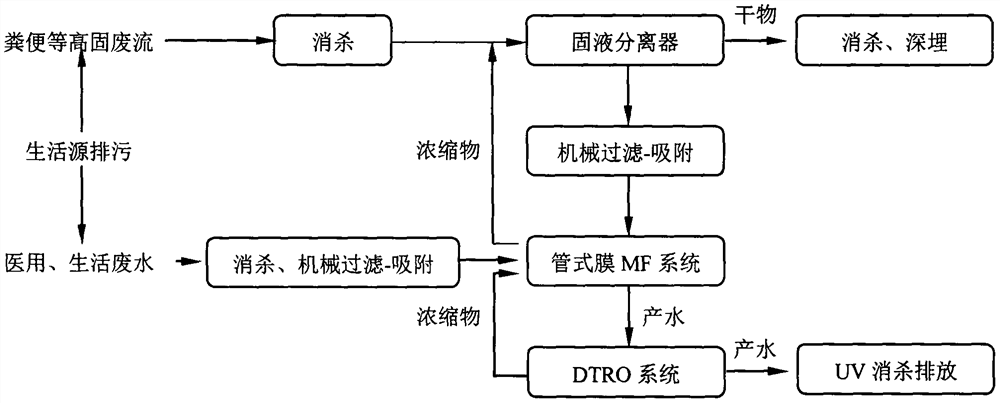Virus wastewater treatment process
A wastewater treatment and process technology, applied in the fields of pathogenic microorganism wastewater treatment, water/sewage treatment, light water/sewage treatment, etc., can solve the problems of virus leakage, large amount of concentrated products, and large amount of terminal waste, and achieve proper treatment. Effect
- Summary
- Abstract
- Description
- Claims
- Application Information
AI Technical Summary
Problems solved by technology
Method used
Image
Examples
Embodiment Construction
[0012] The invention provides a virus wastewater treatment process, which is described below with reference to the accompanying drawings.
[0013] Sewage from domestic sources includes high-solid waste streams such as feces and medical and domestic wastewater. For high-solid waste streams such as feces, it is first sterilized, and then fully sealed for solid-liquid separation. The resulting concentrate is compressed into blocks for disinfection and deep burial, and the resulting liquid enters the tubular membrane microfiltration system for treatment. For medical and domestic wastewater, it is first sterilized and mechanically filtered, then enters the tubular membrane microfiltration system for primary membrane treatment, and then enters the disc tube reverse osmosis system for secondary membrane treatment, and the final product water can be discharged after ultraviolet disinfection .
PUM
 Login to View More
Login to View More Abstract
Description
Claims
Application Information
 Login to View More
Login to View More - R&D
- Intellectual Property
- Life Sciences
- Materials
- Tech Scout
- Unparalleled Data Quality
- Higher Quality Content
- 60% Fewer Hallucinations
Browse by: Latest US Patents, China's latest patents, Technical Efficacy Thesaurus, Application Domain, Technology Topic, Popular Technical Reports.
© 2025 PatSnap. All rights reserved.Legal|Privacy policy|Modern Slavery Act Transparency Statement|Sitemap|About US| Contact US: help@patsnap.com

